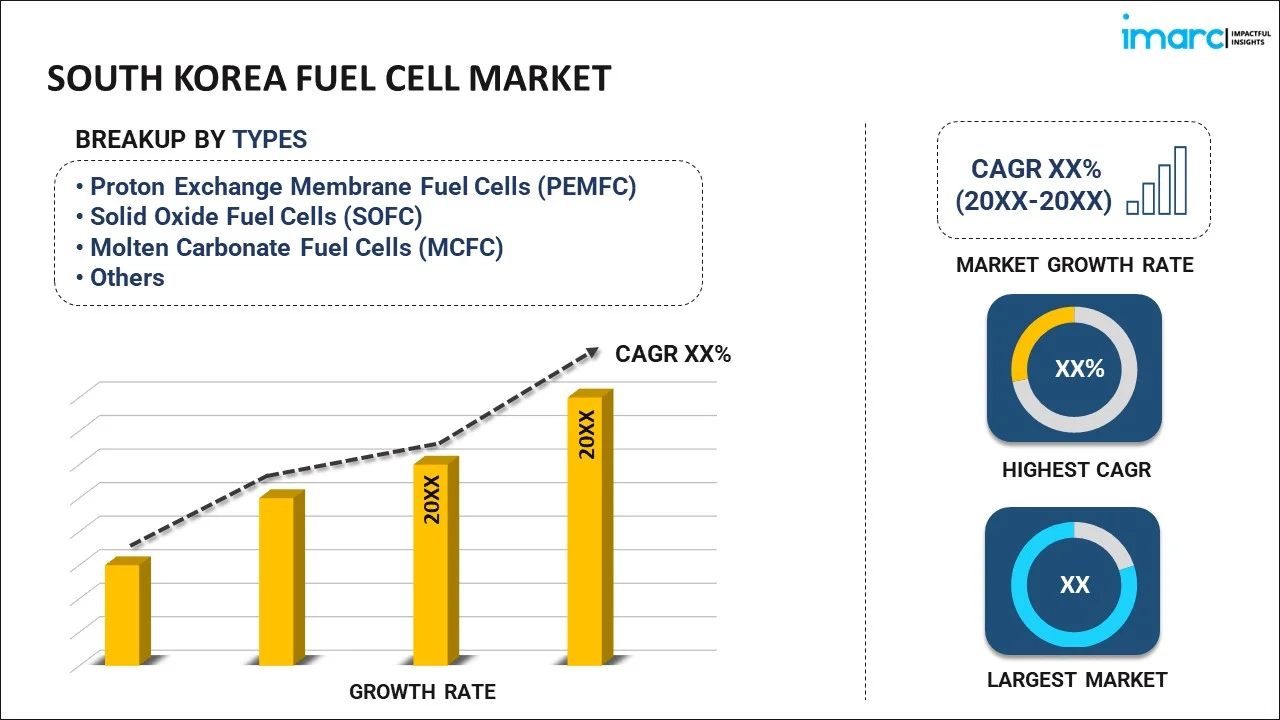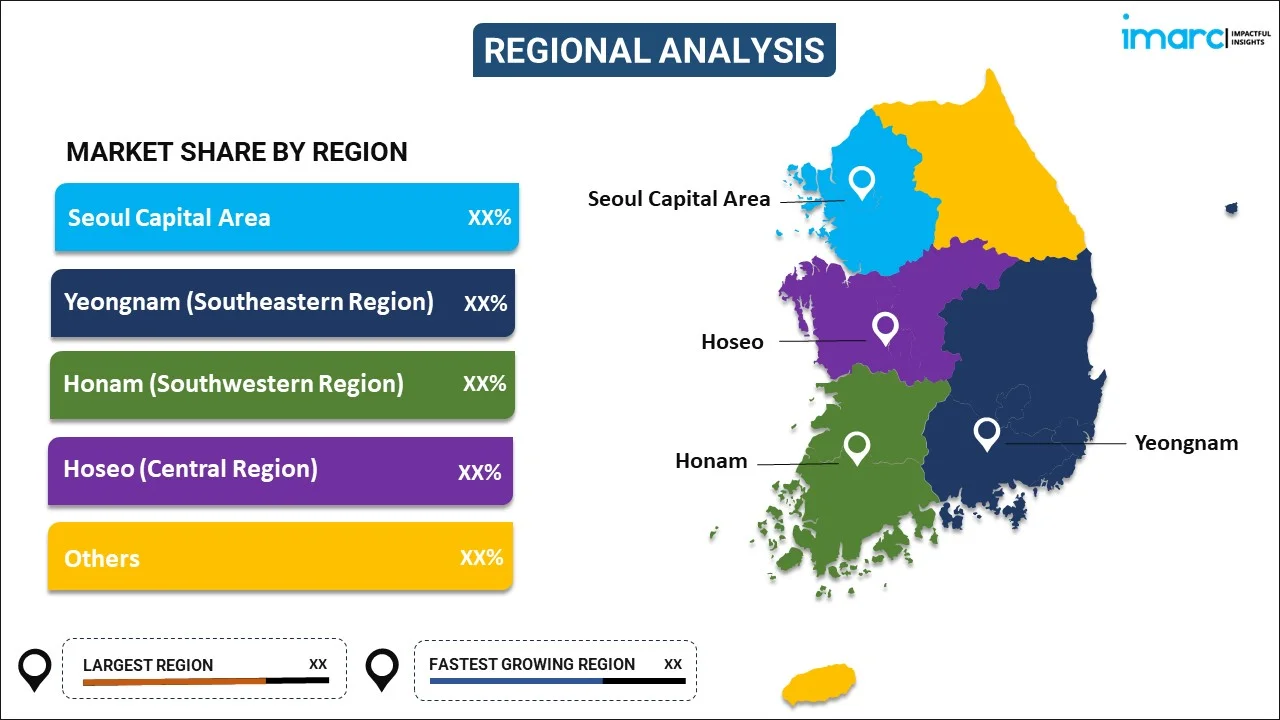
South Korea Fuel Cell Market Report by Type (Proton Exchange Membrane Fuel Cells (PEMFC), Solid Oxide Fuel Cells (SOFC), Molten Carbonate Fuel Cells (MCFC), Direct Methanol Fuel Cells (DMFC), Phosphoric Acid Fuel Cells (PAFC), and Others), Application (Stationary, Transportation, Portable), and Region 2024-2032
Market Overview:
South Korea fuel cell market size is projected to exhibit a growth rate (CAGR) of 19.10% during 2024-2032. The ongoing R&D efforts, which have led to advancements in fuel cell technology, making them more efficient, reliable, and cost-effective, are driving the market.
|
Report Attribute
|
Key Statistics
|
|---|---|
|
Base Year
|
2023
|
|
Forecast Years
|
2024-2032
|
|
Historical Years
|
2018-2023
|
| Market Growth Rate 2024-2032 | 19.10% |
A fuel cell is an electrochemical device that converts chemical energy directly into electrical energy through the reaction between a fuel and an oxidizing agent, typically hydrogen and oxygen. It operates on the principle of harnessing the energy released during this reaction to generate electricity, with water and heat as the primary byproducts. Unlike traditional combustion-based power generation, fuel cells offer higher energy efficiency and produce fewer pollutants, making them a promising and environmentally friendly alternative for power generation. Fuel cells find applications in various sectors, including transportation, stationary power generation, and portable electronics. Their scalability and potential for clean energy production contribute to ongoing R&D efforts aimed at improving efficiency, reducing costs, and expanding their widespread adoption in the quest for sustainable energy solutions.
South Korea Fuel Cell Market Trends:
The fuel cell market in South Korea is experiencing robust growth, driven by various factors that collectively underscore its promising future. Firstly, the increasing regional emphasis on sustainability has propelled the demand for clean energy alternatives, positioning fuel cells as a pivotal player in the transition towards greener solutions. Furthermore, advancements in technology have enhanced the efficiency and reliability of fuel cells, making them increasingly attractive for various applications. In addition, governmental support and incentives in South Korea are providing a substantial boost to the fuel cell market, fostering research, development, and widespread adoption. Moreover, the growing awareness of environmental concerns, coupled with stringent regulations on emissions, is compelling industries to explore cleaner energy sources, thereby escalating the demand for fuel cells. The versatility of fuel cells across sectors such as automotive, residential, and industrial further contributes to their expanding market share. Additionally, ongoing R&D initiatives aimed at reducing production costs and improving scalability are pivotal in shaping the market dynamics positively. In summary, the confluence of environmental consciousness, technological innovation, governmental backing, and expanding applications underscores the significant and multifaceted drivers propelling the regional fuel cell market forward in the coming years.
South Korea Fuel Cell Market Segmentation:
IMARC Group provides an analysis of the key trends in each segment of the market, along with forecasts at the country level for 2024-2032. Our report has categorized the market based on type and application.
Type Insights:

- Proton Exchange Membrane Fuel Cells (PEMFC)
- Solid Oxide Fuel Cells (SOFC)
- Molten Carbonate Fuel Cells (MCFC)
- Direct Methanol Fuel Cells (DMFC)
- Phosphoric Acid Fuel Cells (PAFC)
- Others
The report has provided a detailed breakup and analysis of the market based on the type. This includes proton exchange membrane fuel cells (PEMFC), solid oxide fuel cells (SOFC), molten carbonate fuel cells (MCFC), direct methanol fuel cells (DMFC), phosphoric acid fuel cells (PAFC), and others.
Application Insights:
- Stationary
- Transportation
- Portable
A detailed breakup and analysis of the market based on the application have also been provided in the report. This includes stationary, transportation, and portable.
Regional Insights:

- Seoul Capital Area
- Yeongnam (Southeastern Region)
- Honam (Southwestern Region)
- Hoseo (Central Region)
- Others
The report has also provided a comprehensive analysis of all the major regional markets, which include Seoul Capital Area, Yeongnam (Southeastern Region), Honam (Southwestern Region), Hoseo (Central Region), and Others.
Competitive Landscape:
The market research report has also provided a comprehensive analysis of the competitive landscape in the market. Competitive analysis such as market structure, key player positioning, top winning strategies, competitive dashboard, and company evaluation quadrant has been covered in the report. Also, detailed profiles of all major companies have been provided.
South Korea Fuel Cell Market Report Coverage:
| Report Features | Details |
|---|---|
| Base Year of the Analysis | 2023 |
| Historical Period | 2018-2023 |
| Forecast Period | 2024-2032 |
| Units | US$ Million |
| Scope of the Report | Exploration of Historical and Forecast Trends, Industry Catalysts and Challenges, Segment-Wise Historical and Predictive Market Assessment:
|
| Types Covered | Proton Exchange Membrane Fuel Cells (PEMFC), Solid Oxide Fuel Cells (SOFC), Molten Carbonate Fuel Cells (MCFC), Direct Methanol Fuel Cells (DMFC), Phosphoric Acid Fuel Cells (PAFC), Others |
| Applications Covered | Stationary, Transportation, Portable |
| Regions Covered | Seoul Capital Area, Yeongnam (Southeastern Region), Honam (Southwestern Region), Hoseo (Central Region), Others |
| Customization Scope | 10% Free Customization |
| Report Price and Purchase Option | Single User License: US$ 3699 Five User License: US$ 4699 Corporate License: US$ 5699 |
| Post-Sale Analyst Support | 10-12 Weeks |
| Delivery Format | PDF and Excel through Email (We can also provide the editable version of the report in PPT/Word format on special request) |
Key Questions Answered in This Report:
- How has the South Korea fuel cell market performed so far and how will it perform in the coming years?
- What has been the impact of COVID-19 on the South Korea fuel cell market?
- What is the breakup of the South Korea fuel cell market on the basis of type?
- What is the breakup of the South Korea fuel cell market on the basis of application?
- What are the various stages in the value chain of the South Korea fuel cell market?
- What are the key driving factors and challenges in the South Korea fuel cell?
- What is the structure of the South Korea fuel cell market and who are the key players?
- What is the degree of competition in the South Korea fuel cell market?
Key Benefits for Stakeholders:
- IMARC’s industry report offers a comprehensive quantitative analysis of various market segments, historical and current market trends, market forecasts, and dynamics of the South Korea fuel cell market from 2018-2032.
- The research report provides the latest information on the market drivers, challenges, and opportunities in the South Korea fuel cell market.
- Porter's five forces analysis assist stakeholders in assessing the impact of new entrants, competitive rivalry, supplier power, buyer power, and the threat of substitution. It helps stakeholders to analyze the level of competition within the South Korea fuel cell industry and its attractiveness.
- Competitive landscape allows stakeholders to understand their competitive environment and provides an insight into the current positions of key players in the market.
Need more help?
- Speak to our experienced analysts for insights on the current market scenarios.
- Include additional segments and countries to customize the report as per your requirement.
- Gain an unparalleled competitive advantage in your domain by understanding how to utilize the report and positively impacting your operations and revenue.
- For further assistance, please connect with our analysts.
 Inquire Before Buying
Inquire Before Buying
 Speak to an Analyst
Speak to an Analyst
 Request Brochure
Request Brochure
 Request Customization
Request Customization




.webp)




.webp)












